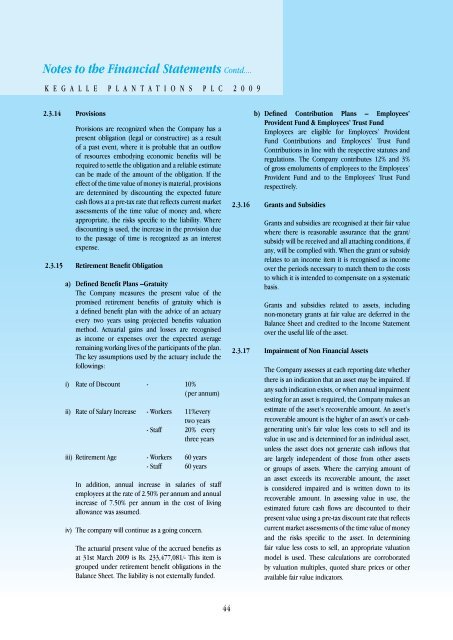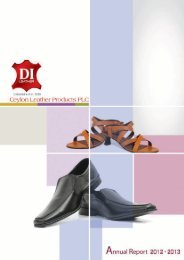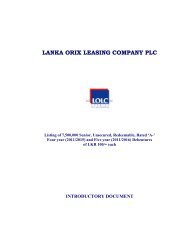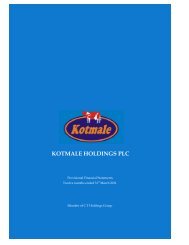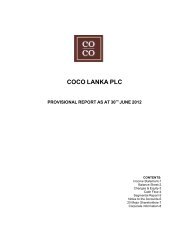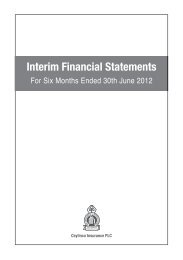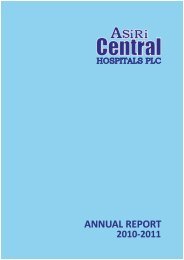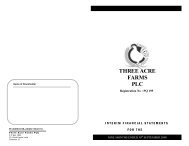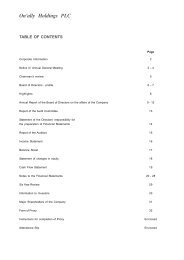Notes to the Financial Statements Contd.... - Colombo Stock Exchange
Notes to the Financial Statements Contd.... - Colombo Stock Exchange
Notes to the Financial Statements Contd.... - Colombo Stock Exchange
You also want an ePaper? Increase the reach of your titles
YUMPU automatically turns print PDFs into web optimized ePapers that Google loves.
<strong>Notes</strong> <strong>to</strong> <strong>the</strong> <strong>Financial</strong> <strong>Statements</strong> <strong>Contd</strong>....<br />
K E G A L L E P L A N T A T I O N S P L C 2 0 0 9<br />
2.3.14 Provisions<br />
Provisions are recognized when <strong>the</strong> Company has a<br />
present obligation (legal or constructive) as a result<br />
of a past event, where it is probable that an outflow<br />
of resources embodying economic benefits will be<br />
required <strong>to</strong> settle <strong>the</strong> obligation and a reliable estimate<br />
can be made of <strong>the</strong> amount of <strong>the</strong> obligation. If <strong>the</strong><br />
effect of <strong>the</strong> time value of money is material, provisions<br />
are determined by discounting <strong>the</strong> expected future<br />
cash flows at a pre-tax rate that reflects current market<br />
assessments of <strong>the</strong> time value of money and, where<br />
appropriate, <strong>the</strong> risks specific <strong>to</strong> <strong>the</strong> liability. Where<br />
discounting is used, <strong>the</strong> increase in <strong>the</strong> provision due<br />
<strong>to</strong> <strong>the</strong> passage of time is recognized as an interest<br />
expense.<br />
2.3.15 Retirement Benefit Obligation<br />
a) Defined Benefit Plans –Gratuity<br />
The Company measures <strong>the</strong> present value of <strong>the</strong><br />
promised retirement benefits of gratuity which is<br />
a defined benefit plan with <strong>the</strong> advice of an actuary<br />
every two years using projected benefits valuation<br />
method. Actuarial gains and losses are recognised<br />
as income or expenses over <strong>the</strong> expected average<br />
remaining working lives of <strong>the</strong> participants of <strong>the</strong> plan.<br />
The key assumptions used by <strong>the</strong> actuary include <strong>the</strong><br />
followings:<br />
i) Rate of Discount - 10%<br />
(per annum)<br />
ii) Rate of Salary Increase - Workers 11%every<br />
two years<br />
- Staff 20% every<br />
three years<br />
iii) Retirement Age - Workers 60 years<br />
- Staff 60 years<br />
In addition, annual increase in salaries of staff<br />
employees at <strong>the</strong> rate of 2.50% per annum and annual<br />
increase of 7.50% per annum in <strong>the</strong> cost of living<br />
allowance was assumed.<br />
iv) The company will continue as a going concern.<br />
The actuarial present value of <strong>the</strong> accrued benefits as<br />
at 31st March 2009 is Rs. 233,477,081/- This item is<br />
grouped under retirement benefit obligations in <strong>the</strong><br />
Balance Sheet. The liability is not externally funded.<br />
44<br />
b) Defined Contribution Plans – Employees’<br />
Provident Fund & Employees’ Trust Fund<br />
Employees are eligible for Employees’ Provident<br />
Fund Contributions and Employees’ Trust Fund<br />
Contributions in line with <strong>the</strong> respective statutes and<br />
regulations. The Company contributes 12% and 3%<br />
of gross emoluments of employees <strong>to</strong> <strong>the</strong> Employees’<br />
Provident Fund and <strong>to</strong> <strong>the</strong> Employees’ Trust Fund<br />
respectively.<br />
2.3.16 Grants and Subsidies<br />
Grants and subsidies are recognised at <strong>the</strong>ir fair value<br />
where <strong>the</strong>re is reasonable assurance that <strong>the</strong> grant/<br />
subsidy will be received and all attaching conditions, if<br />
any, will be complied with. When <strong>the</strong> grant or subsidy<br />
relates <strong>to</strong> an income item it is recognised as income<br />
over <strong>the</strong> periods necessary <strong>to</strong> match <strong>the</strong>m <strong>to</strong> <strong>the</strong> costs<br />
<strong>to</strong> which it is intended <strong>to</strong> compensate on a systematic<br />
basis.<br />
Grants and subsidies related <strong>to</strong> assets, including<br />
non-monetary grants at fair value are deferred in <strong>the</strong><br />
Balance Sheet and credited <strong>to</strong> <strong>the</strong> Income Statement<br />
over <strong>the</strong> useful life of <strong>the</strong> asset.<br />
2.3.17 Impairment of Non <strong>Financial</strong> Assets<br />
The Company assesses at each reporting date whe<strong>the</strong>r<br />
<strong>the</strong>re is an indication that an asset may be impaired. If<br />
any such indication exists, or when annual impairment<br />
testing for an asset is required, <strong>the</strong> Company makes an<br />
estimate of <strong>the</strong> asset’s recoverable amount. An asset’s<br />
recoverable amount is <strong>the</strong> higher of an asset’s or cashgenerating<br />
unit’s fair value less costs <strong>to</strong> sell and its<br />
value in use and is determined for an individual asset,<br />
unless <strong>the</strong> asset does not generate cash inflows that<br />
are largely independent of those from o<strong>the</strong>r assets<br />
or groups of assets. Where <strong>the</strong> carrying amount of<br />
an asset exceeds its recoverable amount, <strong>the</strong> asset<br />
is considered impaired and is written down <strong>to</strong> its<br />
recoverable amount. In assessing value in use, <strong>the</strong><br />
estimated future cash flows are discounted <strong>to</strong> <strong>the</strong>ir<br />
present value using a pre-tax discount rate that reflects<br />
current market assessments of <strong>the</strong> time value of money<br />
and <strong>the</strong> risks specific <strong>to</strong> <strong>the</strong> asset. In determining<br />
fair value less costs <strong>to</strong> sell, an appropriate valuation<br />
model is used. These calculations are corroborated<br />
by valuation multiples, quoted share prices or o<strong>the</strong>r<br />
available fair value indica<strong>to</strong>rs.


